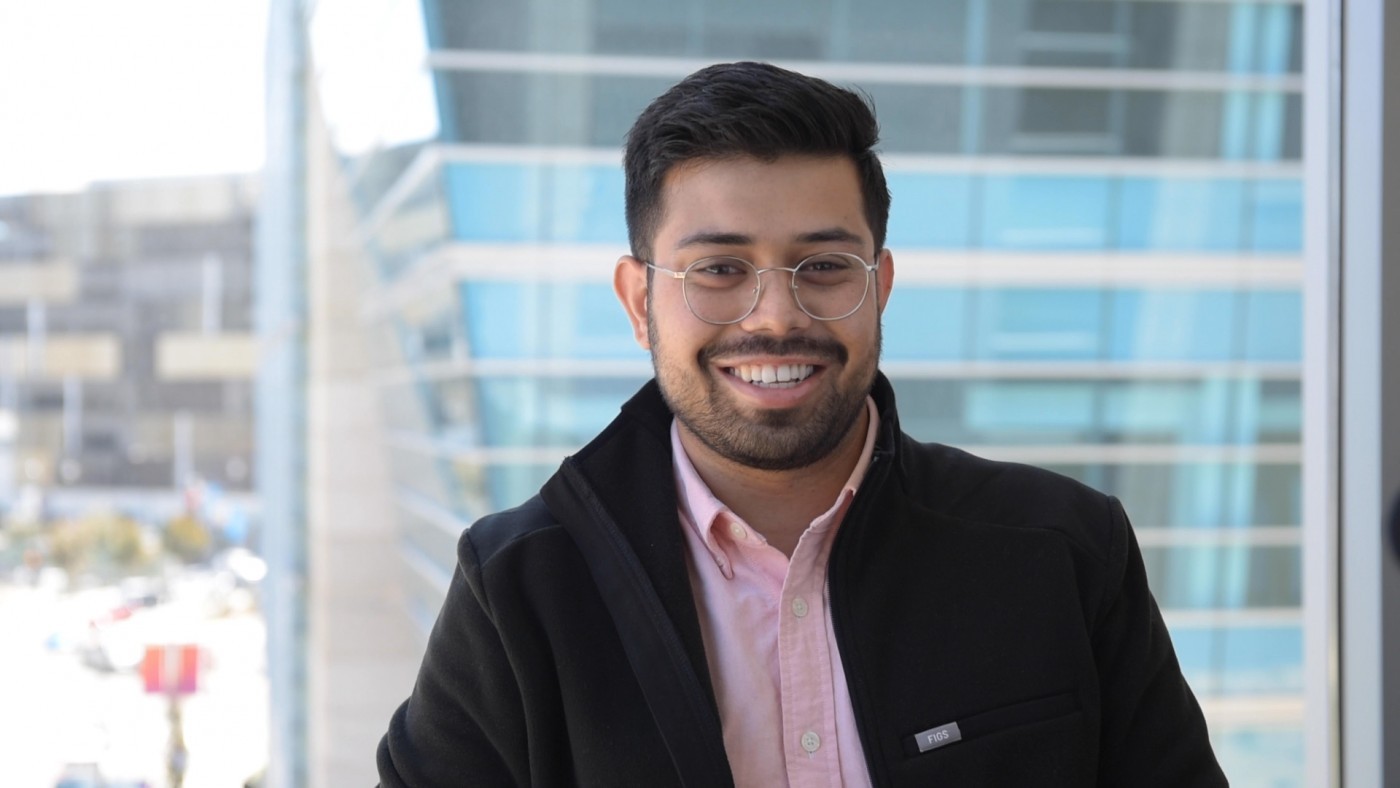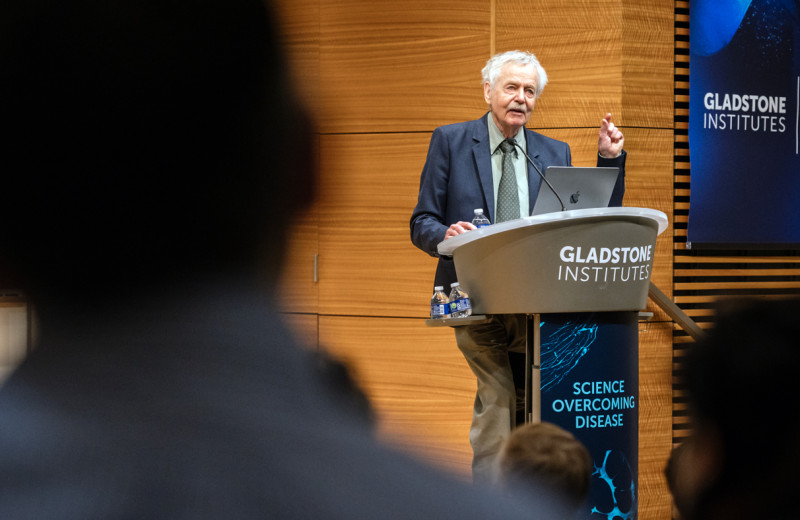Gladstone NOW: The Campaign Join Us on the Journey✕

Kamal Gill started working at Gladstone during the COVID-19 pandemic after having graduated from the University of Pennsylvania in spring 2020.
Kamal Gill (he/him) is a research associate in the laboratory of Bruce Conklin, MD. Originally from the East Bay in Northern California, he’s a second generation Punjabi American, and the first in his family to graduate from college.
Throughout his education, he’s been involved in Asian American activism and, at Gladstone, he’s taken an active role in the LGBTQ+ community group, helping plan and organize 2021’s Out in Science event.
What brought you to Gladstone?
I came to Gladstone because I wanted to be in a space where I could figure out what path I want to take with my scientific career. Gladstone has a combination of scientists with MDs, PhDs, MD/PhDs, Master’s degrees, and other folks who have accomplished so much. And I wanted to come here and learn from them to help me better understand if I want to pursue an MD, PhD, or something else.
I also came to Gladstone because I had a wonderful interview experience with Claire Clelland, MD, PhD, a postdoc in the Conklin Lab. I had a 2-hour interview with her and we talked about her research, her career path, and both our passions for science and social justice. I knew after that experience that this was the place that I wanted to be. I knew I wanted to learn from her and be part of this community.
What do you like about working at Gladstone?
Gladstone is a small organization with a big community feel. You can see that in the way that everyone works with each other. Gladstone really prioritizes the research and creating a nurturing environment. Even though I’m in the Conklin Lab, I’ve been mentored by other labs. I’ve never been afraid to ask questions. And I know that if I can’t find anyone in my lab with the answer to my question, I can ask neighboring labs or facilities, like the Stem Cell Core or Genomics Core.
The other wonderful thing about Gladstone is that because we’re located next to the UC San Francisco Mission Bay campus, we have access to other great researchers and it gives us the ability to easily collaborate with them.
Were you interested in science as a child?
Yes, as a child, I was always interested in figuring out how things worked. I was particularly interested in biology. The idea that you could study life, study components of life, was something that I knew I wanted to do. But besides science, I was also interested in architecture and making things. I think that’s why I really like the research that I do right now because we’re working toward making therapeutics and we're figuring out how to take living things that have mutations or diseases and make them better. And I think there’s really nothing more beautiful than that.
Can you describe your current research project?
The research goal of my team is to use genome surgery to create a therapy for amyotrophic lateral sclerosis (ALS) and frontotemporal dementia (FTD), which are both neurological diseases.
We take a patient’s cells and grow them as induced pluripotent stem cells. We can then take these cells and turn them into motor neurons or other cells that we’re interested in studying. We’re interested in motor neurons because those are the cells that are affected by the disease, so we can see what happens in the cells when they’re sick and can’t function properly.
We then use CRISPR-Cas9, which is a gene-editing technology, to edit the mutant gene present within the cells and see whether we can correct these cells and restore them.
We know we’ve succeeded when our edits to the gene make the cells look and work like a healthy cell. Then we’ll be able to move forward within the process of upgrading that to a therapeutic.
What was it like to start work during a pandemic?
I started working at Gladstone during the pandemic and it was actually a pretty simple transition. This was largely because Gladstone had really great physical distancing, mask wearing, and other protocols, which ensured that while we were working in the building, we were staying safe.
But I think one good thing the pandemic really brought is the introduction of virtual meetings and the use of Slack and other forms of communication. So, even though I was working with people in different cities, and sometimes states, people were only a few seconds away. I think that’s a really wonderful part of working at a place that can adapt so quickly.
What or who influenced your decision to work in science?
I wanted to work in science because I think it allows us to discover things that we don’t yet know exist. Science is this wonderful process of progressing and building the future. And I was really interested in being part of developing the next generation of gene therapy—the next generation of medicine. I think what we’re doing now in our lab, at this institution, has the potential to change lives, and even the world.
How did you get involved with the LGBTQ+ community group at Gladstone?
I first became aware that Gladstone had different community groups while scrolling through the website. I clicked that I was interested in a couple different groups and I ended up receiving an email from the chairs of the LGBTQ+ community at Gladstone. They were asking for volunteers to help organize an event for scientists who are “out.” I was really involved in Asian American activism and planning events at the University of Pennsylvania, and I wanted to contribute some of those skills at Gladstone. I believe you get out what you put in. Because I want to get a lot out of Gladstone, I decided to participate in organizing this event.
How can institutions support their LGBTQ+ staff, particularly STEM organizations?
I think the first thing when it comes to supporting LGBTQ+ staff is decentralizing cisgender and heterosexual perspectives. We need to think about what our institutions look like, even on a really basic level, like access to restrooms. We should make sure that everyone has access to a restroom on each floor, or make sure that hygiene products are not just placed within a gendered restroom because that’s not accessible to all people.
The second thing when it comes to supporting LGBTQ+ staff within STEM is to recognize that we’re all bringing in our own biases and that we may be complacent in systems of oppression. We need to put time and effort into creating plans, policies, and procedures to ensure that we’re prioritizing all our researchers and staff. Each one is a person outside of being a scientist. Some may face discrimination, and they all are people who need to be respected. Institutions have a responsibility to ensure that they’re respecting and providing for these groups. That they’re listening to them, adapting, changing policies based on their needs, and helping them be the best researchers they can be.
What do you do when you are not working?
When I’m not working at Gladstone, I’m involved with a lot of educational nonprofit work. During the COVID-19 pandemic, I started an education nonprofit, called the First Gen Empowerment Project. I work with first-generation and immigrant high school students to provide them with college readiness resources. During the pandemic, we grew from a three-person team to now being a 501c3 nonprofit, with over a dozen people working.
I also volunteer at my former high school here in California as a community member on the school-site council where I help with creating budgets and work on other important initiatives for the school.
What is your hidden or unique talent?
I love to cook but don’t use any recipes. And I think one of my hidden talents is that I’m really good at scrambling different ingredients in kitchens and putting together a meal. I really enjoy the process of experimenting and making things.
If you could meet any scientist from any point in time, who would it be and why?
I want to acknowledge that this is a difficult question but I think I would meet Ben Barres. He was a scientist at Stanford University and did tremendous work on glial cells. You might not have heard of them but glial cells make up the majority of your brain. Barres conducted amazing research.
One thing that I didn’t really know about him until recently was that he was transgender and transitioned while at Stanford University. Afterward, he published a few papers and articles about sexism because his experiences within science changed drastically after his transition.
Want to Join the Team?
Our people are our most important asset. We offer a wide array of career opportunities both in our administrative offices and in our labs.
Explore CareersA Sculptor of Modern Regenerative Medicine
A Sculptor of Modern Regenerative Medicine
Among his myriad accomplishments, Rudolf Jaenisch—winner of the 2025 Ogawa-Yamanaka Stem Cell Prize—was the first to demonstrate the potential of induced pluripotent stem cells to treat disease.
Awards Ogawa Stem Cell Prize Profile Regenerative Medicine Stem Cells/iPSCsMeet Gladstone: Shijie Wang
Meet Gladstone: Shijie Wang
Shijie Wang, a postdoctoral scholar in Steve Finkbeiner’s lab, uses artificial intelligence, robotics, and stem cell technologies to uncover how brain cells die in neurodegenerative diseases like Alzheimer’s and Parkinson’s.
Profile Neurological Disease Finkbeiner Lab AI Robotic MicroscopyMeet Gladstone: Oscar Yip
Meet Gladstone: Oscar Yip
Oscar Yip is advancing Alzheimer’s research in Yadong Huang’s lab at Gladstone while drawing inspiration from his family, community, and his broader goal of helping patients.
Graduate Students and Postdocs Profile Alzheimer’s Disease



